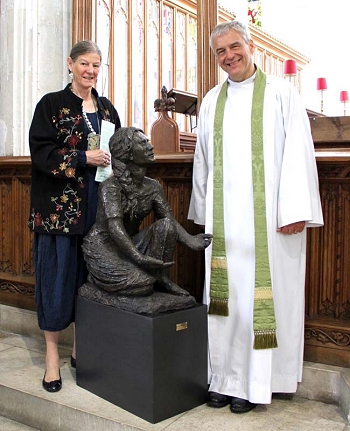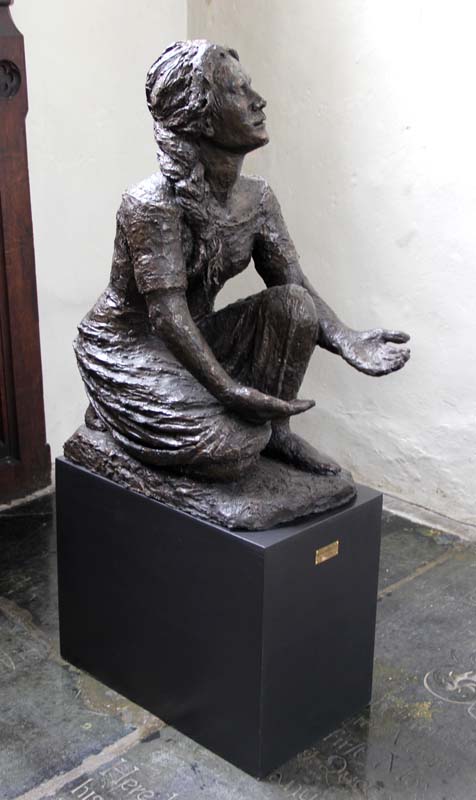The Making of Mary
 Tessa Hawkes and Rector David Tomlinson at the blessing of Tessa’s statuette of Mary – Sept 2014. Tessa Hawkes and Rector David Tomlinson at the blessing of Tessa’s statuette of Mary – Sept 2014. |
Tessa Hawkes gave an account of the making of Mary in Parish News for October 2014. In retelling the story to 20 fascinated listeners, she gave some new details.
In introducing the talk, Sue Walker said that Tessa had originally been reluctant to make the presentation but subsequently agreed. As we approached the patronal feast for Mary this seemed an appropriate time to share the experience of making Mary.
Tessa said that before her husband Russell’s death, the rector David Tomlinson asked Tessa whether she was interested in making something for the church. She found this very trusting of David but a great challenge. Obviously, some version of Mary would be most appropriate. After some thought, she went to the garage which was full of old bicycles and things and constructed a base from two planks as she started thinking what she would make.
Usually she would have needed a strong steel armature for the skeleton but it was too late as the form was already taking shape. In fact, it transpired that the lack of flexibility of a steel structure would have prevented the later development of the piece. She next made a clay model maquette of one third size of what the final piece would be like and this was photographed for PCC approval and subsequent faculty grant.
Some questions filtered back from the diocese whether the concept was too Roman Catholic or part of a Marian cult – she never would have started if she had anticipated such questions! However, the faculty was granted following DAC recommendation and she started to make the statuette.
As indicated, the skeleton was put together with broom sticks and jubilee clips on the base and built up to a thinner structure than the final work with newspaper, coat hangers and chicken wire. The worst part of actually beginning the task was now over, and modelling began with plaster of Paris. This involved using a basin of ½ pint of warm water (it was winter) and 5½ handfuls of plaster of Paris and some torn up newspaper, which was left to slake for 3 minutes and then applied in the 10 minutes within which the plaster of Paris remained workable before it set hard. To be able to work quickly she had notes written in charcoal on the garage wall to remind her, for example, to include 5 fingers, and to raise the chin. So, the work began to come together with additional sculpturing by chipping back the plaster to shape with a chisel and mallet.
The work then took on a will of its own. Tessa’s original intention was for Mary’s arms to be outstretched, saying, “Why me?” However, one arm dropped and then the other, Tessa couldn’t understand how, until Mary seemed to be saying, “Thy will be done”. She had a baby alarm in the garage to keep in touch with her husband. As her husband was fading, Mary was developing, which gave Tessa a strange strength. She covered Mary at night with a blanket to keep her warm. There was then trouble with Mary’s back – Tessa had meant to make her bent and vulnerable but her back kept straightening overnight.
 Tessa added buttons down her back to retain her innocence but realised Mary needed a strong back for the load she was to carry. When Tessa had finished as far as she could go, she and her son and son in law brought her to church wrapped in duvets in a wheelbarrow, to consider her placement and lighting and the height of the plinth and found the present spot. However, while her grandson was kneeling at the altar he said, “Granny, I can see her knickers!” This was easily remedied with an extra petticoat.
Tessa added buttons down her back to retain her innocence but realised Mary needed a strong back for the load she was to carry. When Tessa had finished as far as she could go, she and her son and son in law brought her to church wrapped in duvets in a wheelbarrow, to consider her placement and lighting and the height of the plinth and found the present spot. However, while her grandson was kneeling at the altar he said, “Granny, I can see her knickers!” This was easily remedied with an extra petticoat.
The next chapter was to take Mary to the foundry to be cast. The foundry is an amazing blackened, Dickensian building in Docklands with high windows and is lit mainly from the furnace and molten bronze, with just silhouettes of the men working. Mary would recognise this from foundries going back to ancient Greece and would feel at home. However, when the white van came to collect Mary she looked lonely in the back as Tessa waved her off with a tear, like seeing a child off to start school. This was followed by trips to and fro to the foundry until a final signing and dating. The statuette was then cast in cold bronze i.e. bronze powder in a resin base (a solid bronze model would be too vulnerable to theft and melting down). Finally, the plinth was painted and the brass plaque added and she is now here to stay and seems happy to be here.
In response to questions, Tessa added the following details.
The patination is integral to the material, not applied to the surface.
The statuette is hollow.
There was no finishing to do to the cast model once it was returned, “except to avoid looking at the mistakes”
Tessa applies a wax polish from time to time.
She will outlast all of us if kept frost free – she enjoys the new heating system
Tessa was very grateful to David for giving her something to keep her mind occupied at a very difficult time.
Tessa confirmed that her initial approach was to display Mary at a very early stage in the annunciation of a young girl completely bewildered but the eventual model was of a later stage in the annunciation of acceptance, but still a little bewildered.
In concluding Sue said that Tessa’s journey was relevant to us all, and prayed that in our journey, like Mary with struggles and transformation working through fear, we may be able to say, “Yes” to God.
Sue Walker – October 2017